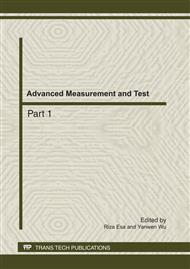[1]
Y.J. Lu, M. MA: Fast image matching algorithm based on grey particle swarm optimization. Computer Engineering and Applications. Vol. 45(10), pp.157-167, (2009).
Google Scholar
[2]
Y.Q. WU, S. CHEN: Remote sensing image matching based on Contourlet-domain krawtchouk moments and improved particle swarm optimization. Journal of Astronautics, Vol. 31(2), pp.514-520, (2010).
Google Scholar
[3]
Q. Zhu, B. Wu, Z. Xu: Seed point selection method for triangle constrained image matching propagation. IEEE Geoscience and Remote Sensing Letters, Vol. 3(2), pp.207-211, (2006).
DOI: 10.1109/lgrs.2005.861735
Google Scholar
[4]
J. Zhou, J.Y. Shi: A robust algorithm for feature point matching. Computers & Graphics, vol. 26(3), pp.429-436, (2002).
DOI: 10.1016/s0097-8493(02)00086-9
Google Scholar
[5]
J. You, P. Bhattacharya: A wavelet-based coarse-to-fine image matching scheme in a parallel virtual machine environment. IEEE Transaction on Image Processing, Vol. 9(9), pp.1547-1559, (2000).
DOI: 10.1109/83.862635
Google Scholar
[6]
K.M. Passino: Biomimicry of bacterial foraging for distributed optimization and control. IEEE Control Systems Magazine, Vol. 22 (3), pp.52-67, (2002).
DOI: 10.1109/mcs.2002.1004010
Google Scholar
[7]
J. Cho, M. Chun, D. Lee: Parameter optimization of extreme learning machine using bacterial foraging algorithm. ISAI Systems, Cokcho, Korea, Sept 2007, pp.5-8, (2008).
Google Scholar
[8]
Y. Chu, Z.B. Shao, H Mi, Q.H. Wu: An application of bacterial foraging algorithm in image compression. Journal of Shenzhen University Science and Engineering, Vol. 25 (2), pp.153-157, (2008).
Google Scholar
[9]
Y.L. Zhou: Research and application on bacteria foraging optimization algorithm. Computer Engineering and Applications, Vol. 46 (20), pp.16-21 (2010).
Google Scholar
[10]
LIU Bao-sheng, YAN Li-ping, ZHOU Dong-hua: Comparison of Some Classical Similarity Measures [J]. Application Research of Computers, Vol. 11, pp.1-3, (2006).
Google Scholar
[11]
Y.J. Lu, M. MA: Fast image matching algorithm based on grey particle swarm optimization. Computer Engineering and Applications. Vol. 45(10), pp.157-167, (2009).
Google Scholar
[12]
D.I. Barnea, H.F. Silverman: A class of algorithm for fast digital image registration. IEEE Transaction on Computers, Vol. C-21(2), pp.176-186, (1972).
DOI: 10.1109/tc.1972.5008923
Google Scholar


